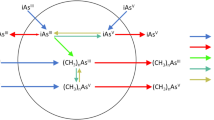Abstract.
Biomethylation is considered a major detoxification pathway for inorganic arsenicals (iAs). According to the postulated metabolic scheme, the methylation of iAs yields methylated metabolites in which arsenic is present in both pentavalent and trivalent forms. Pentavalent mono- and dimethylated arsenicals are less acutely toxic than iAs. However, little is known about the toxicity of trivalent methylated species. In the work reported here the toxicities of iAs and trivalent and pentavalent methylated arsenicals were examined in cultured human cells derived from tissues that are considered a major site for iAs methylation (liver) or targets for carcinogenic effects associated with exposure to iAs (skin, urinary bladder, and lung). To characterize the role of methylation in the protection against toxicity of arsenicals, the capacities of cells to produce methylated metabolites were also examined. In addition to human cells, primary rat hepatocytes were used as methylating controls. Among the arsenicals examined, trivalent monomethylated species were the most cytotoxic in all cell types. Trivalent dimethylated arsenicals were at least as cytotoxic as trivalent iAs (arsenite) for most cell types. Pentavalent arsenicals were significantly less cytotoxic than their trivalent analogs. Among the cell types examined, primary rat hepatocytes exhibited the greatest methylation capacity for iAs followed by primary human hepatocytes, epidermal keratinocytes, and bronchial epithelial cells. Cells derived from human bladder did not methylate iAs. There was no apparent correlation between susceptibility of cells to arsenic toxicity and their capacity to methylate iAs. These results suggest that (1) trivalent methylated arsenicals, intermediary products of arsenic methylation, may significantly contribute to the adverse effects associated with exposure to iAs, and (2) high methylation capacity does not protect cells from the acute toxicity of trivalent arsenicals.
Similar content being viewed by others
Author information
Authors and Affiliations
Additional information
Electronic Publication
Rights and permissions
About this article
Cite this article
Styblo, M., Del Razo, L., Vega, L. et al. Comparative toxicity of trivalent and pentavalent inorganic and methylated arsenicals in rat and human cells. Arch Toxicol 74, 289–299 (2000). https://doi.org/10.1007/s002040000134
Received:
Accepted:
Issue Date:
DOI: https://doi.org/10.1007/s002040000134




